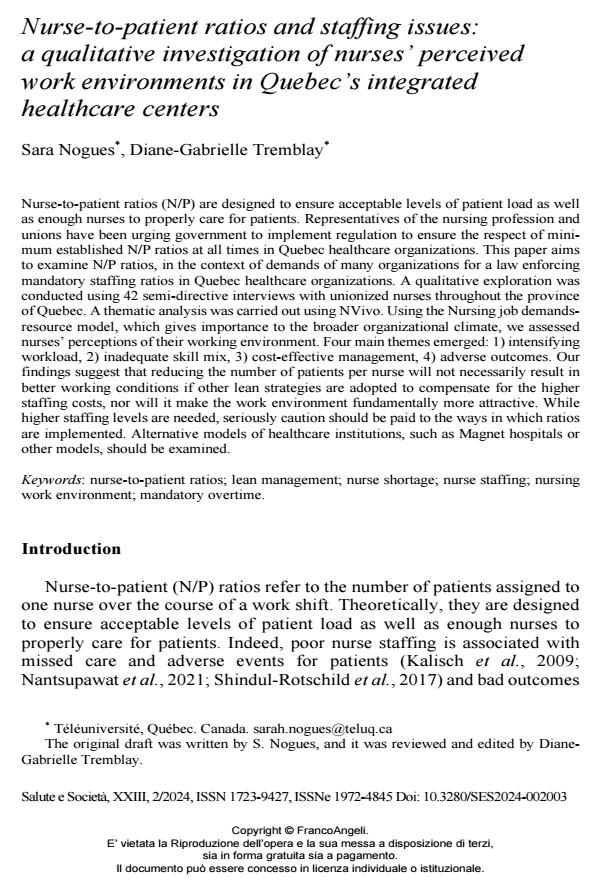Nurse-to-patient ratios and staffing issues: a qualitative investigation of nurses’ perceived work environments in Quebec’s integrated healthcare centers
Titolo Rivista SALUTE E SOCIETÀ
Autori/Curatori Sara Nogues, Diane-Gabrielle Tremblay
Anno di pubblicazione 2024 Fascicolo 2024/2
Lingua Inglese Numero pagine 20 P. 33-52 Dimensione file 314 KB
DOI 10.3280/SES2024-002003
Il DOI è il codice a barre della proprietà intellettuale: per saperne di più
clicca qui
Qui sotto puoi vedere in anteprima la prima pagina di questo articolo.
Se questo articolo ti interessa, lo puoi acquistare (e scaricare in formato pdf) seguendo le facili indicazioni per acquistare il download credit. Acquista Download Credits per scaricare questo Articolo in formato PDF

FrancoAngeli è membro della Publishers International Linking Association, Inc (PILA)associazione indipendente e non profit per facilitare (attraverso i servizi tecnologici implementati da CrossRef.org) l’accesso degli studiosi ai contenuti digitali nelle pubblicazioni professionali e scientifiche
Nurse-to-patient ratios (N/P) are designed to ensure acceptable levels of patient load as well as enough nurses to properly care for patients. Representatives of the nursing profession and unions have been urging government to implement regulation to ensure the respect of mini-mum established N/P ratios at all times in Quebec healthcare organizations. This paper aims to examine N/P ratios, in the context of demands of many organizations for a law enforcing mandatory staffing ratios in Quebec healthcare organizations. A qualitative exploration was conducted using 42 semi-directive interviews with unionized nurses throughout the province of Quebec. A thematic analysis was carried out using NVivo. Using the Nursing job de-mands-resource model, which gives importance to the broader organizational climate, we assessed nurses’ perceptions of their working environment. Four main themes emerged: 1) intensifying workload, 2) inadequate skill mix, 3) cost-effective management, 4) adverse outcomes. Our findings suggest that reducing the number of patients per nurse will not neces-sarily result in better working conditions if other lean strategies are adopted to compensate for the higher staffing costs, nor will it make the work environment fundamentally more attractive. While higher staffing levels are needed, seriously caution should be paid to the ways in which ratios are implemented. Alternative models of healthcare institutions, such as Magnet hospitals or other models, should be examined.
Parole chiave:nurse-to-patient ratios; lean management; nurse shortage; nurse staffing; nursing work environment; mandatory overtime.
- Nurses’ and Contextual Characteristics as Predictors of Missed Care in Portuguese Oncology Settings: A Cross‐Sectional Correlational Study Ivo Cristiano Soares Paiva, Eduardo José Ferreira dos Santos, Filipa Isabel Quaresma Santos Ventura, António Carlos Lopes Vilela, Isabel Maria Pinheiro Borges Moreira, Foroozan Atashzadeh-Shoorideh, in Nursing Forum 9205490/2025
DOI: 10.1155/nuf/9205490
Sara Nogues, Diane-Gabrielle Tremblay, Nurse-to-patient ratios and staffing issues: a qualitative investigation of nurses’ perceived work environments in Quebec’s integrated healthcare centers in "SALUTE E SOCIETÀ" 2/2024, pp 33-52, DOI: 10.3280/SES2024-002003